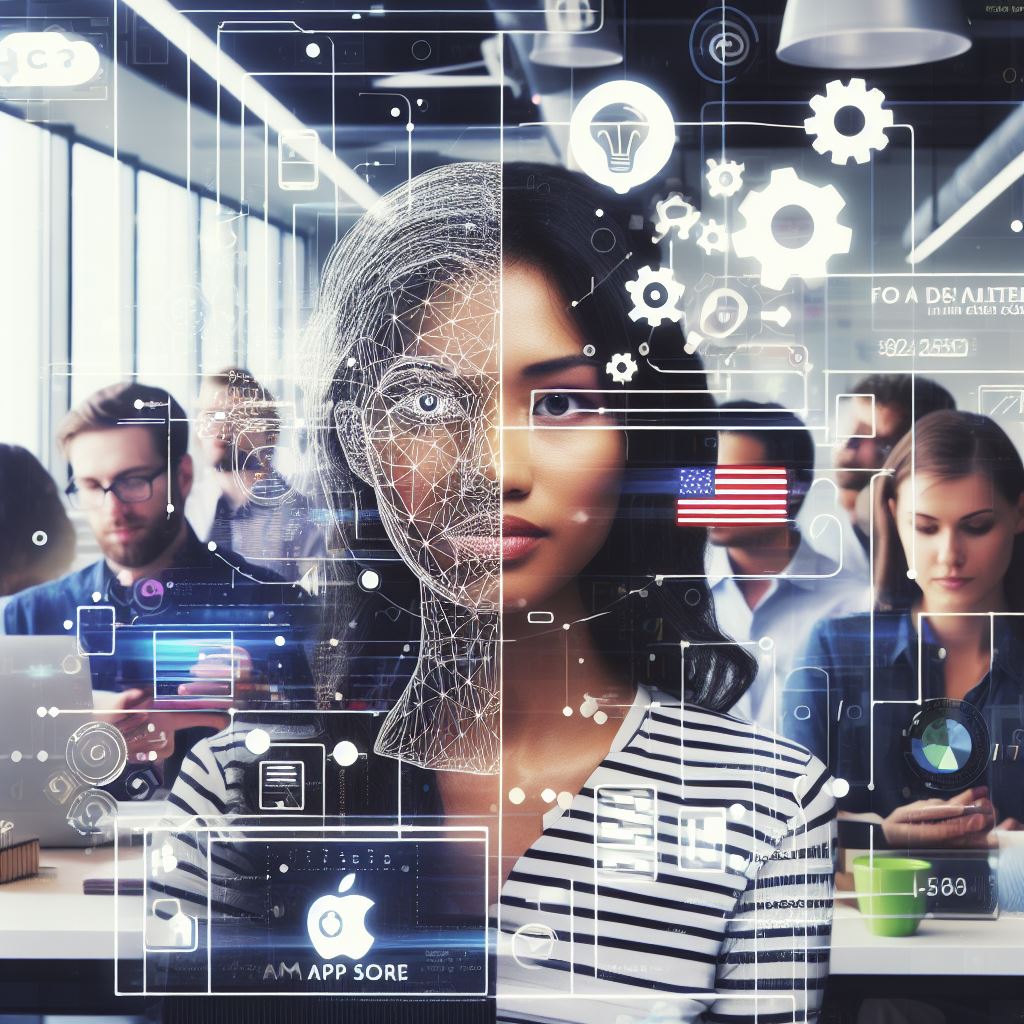Introduction
Augmented reality, an emerging tech, overlays computer info on the real world, gaining traction with ongoing advancements.
This blog explores U.S. coders shaping new realities through AR.
Augmented Reality (AR) redefines perception by merging digital elements with the real world.
Its popularity burgeons as technology advances, reshaping industries. U.S. coders stand at the forefront, shaping augmented realities in diverse ways:
- Enhanced User Experiences: Coders elevate consumer interactions through immersive digital overlays in real environments.
- Entertainment and Gaming: Augmented reality enriches gaming and entertainment, offering unprecedented interactive experiences.
- Education and Training: U.S. coders pioneer AR applications in education, creating dynamic learning environments and realistic training simulations.
- Healthcare Innovations: Augmented reality aids medical procedures, with U.S. coders developing solutions for surgical guidance and diagnostics.
- Retail and Marketing: Coders craft AR solutions for retail, allowing customers to virtually try products before purchasing.
- Architectural Visualization: U.S. coders contribute to AR in architecture, enabling architects to visualize designs in real-world settings.
- Navigation and Tourism: Augmented reality transforms navigation and tourism, providing enriched location-based information and immersive travel experiences.
This blog delves into the vibrant tapestry of U.S. coders at the forefront of AR innovation, reshaping realities across industries.
From entertainment to healthcare, their ingenuity propels augmented reality into a new era, offering boundless possibilities for the future.
Explore how U.S. coders are turning augmented dreams into tangible, transformative realities.
Definition of Augmented Reality
Augmented reality (AR) merges digital data with the real world, enriching our perception. Unlike VR, which immerses completely, AR overlays digital content for interactive real-time interaction.
This concept integrates computer-generated info into our physical surroundings via technologies like cameras, sensors, and displays.
Popular Augmented Reality Applications and Devices
- Pokemon Go: This mobile game took the world by storm in 2016, allowing users to catch virtual Pokemon characters in real-world locations.
- Snapchat Filters: Snapchat introduced dynamic AR filters that overlay funny and interactive virtual elements onto users’ faces.
- Google Maps Live View: This feature helps users navigate the real world by overlaying arrows and directions onto the live camera view in Google Maps.
- AR Shopping: Many retail brands provide apps that allow users to try out virtual furniture, clothes, or makeup before making a purchase.
- AR Gaming: Besides Pokemon Go, various AR games, such as “The Walking Dead: Our World” and “Ingress,” enable players to interact with virtual elements in the real world.
- Industrial Applications: AR is also utilized in industries like manufacturing and construction to enhance worker productivity and safety.
- Education and Training: AR is increasingly being used in educational settings to provide interactive and engaging learning experiences.
- AR in Healthcare: This technology has been applied to assist medical professionals in areas like surgery planning, patient education, and therapy.
- AR in Architecture and Design: AR enables architects and designers to visualize and present their concepts in a more interactive and realistic way.
- Social Media AR: Platforms like Facebook and Instagram offer AR features for users to add filters, effects, and interactive elements to their posts and stories.
As technology advances, AR applications and devices expand. AR-enhanced smartphones and smart glasses increase immersive usage in various fields.
Augmented reality enriches our perception and interaction with the real world, overlaying digital content.
It empowers entertainment, education, navigation, and more. Augmented reality enhances our reality; it doesn’t escape it.
Read: The Job Market for Coding School Graduates in 2024
Overview of the Augmented Reality Market
Augmented reality (AR) overlays computer-generated content on the real world, boosting perception and creating mixed reality. The U.S. AR market’s explosive growth is projected to reach $200 billion by 2025, driven by adoption across industries like gaming, education, and healthcare.
In gaming, AR transforms user interaction, as seen in Pokémon Go and Minecraft Earth. AR immerses players in virtual worlds within the real environment, elevating excitement and engagement.
Tech Consulting Tailored to Your Coding Journey
Get expert guidance in coding with a personalized consultation. Receive unique, actionable insights delivered in 1-3 business days.
Get StartedEducation is another sector where AR is making a significant impact.
AR technology provides a unique and interactive learning experience that helps students visualize complex concepts.
For example, students can explore the human anatomy in 3D or visit historical landmarks virtually.
This hands-on approach to learning improves retention and understanding, making AR an invaluable tool for educators.
AR technology advances benefit healthcare with real-time image visualization during surgeries and realistic medical training.
Key players include Magic Leap and Microsoft. Apple and Google innovate too.
Businesses explore AR for retail and real estate, poised for growth across industries. AR transforms perception and interaction, revolutionizing lives.

U.S. Coders and Their Contribution
When it comes to the Augmented Reality (AR) industry, U.S. coders play a prominent role.
Their coding expertise has driven substantial AR advancements, making them valuable contributors to AR application and experience development.
Coding skills and expertise required for AR development
- Strong knowledge of programming languages such as C++, C#, and Java is essential for AR development.
- Understanding computer vision and image recognition algorithms is crucial for creating realistic AR experiences.
- Proficiency in mobile app development frameworks like Unity and Unreal Engine is necessary for building AR apps.
- Ability to work with spatial mapping and tracking technologies is important for creating accurate and seamless AR interactions.
Examples of successful U.S. coders in the AR field
1. Mark Zuckerberg
As one of the co-founders of Facebook, Zuckerberg has shown a keen interest in AR and its potential to transform various industries.
Through Facebook’s AR Studio, he has enabled coders to create AR effects for the social media platform, making AR more accessible to a wider user base.
2. Tim Sweeney
Sweeney is the CEO and founder of Epic Games, the company behind the popular game development engine, Unreal Engine.
Unreal Engine provides coders with powerful AR development tools that have been used in the creation of numerous successful AR experiences, including games and immersive simulations.
Build Your Vision, Perfectly Tailored
Get a custom-built website or application that matches your vision and needs. Stand out from the crowd with a solution designed just for you—professional, scalable, and seamless.
Get Started3. John Hanke
Hanke is the CEO of Niantic, the company responsible for developing Pokemon Go, one of the most successful AR games to date.
By combining GPS technology and augmented reality, Hanke and his team have created an engaging and widely adored AR gaming experience.
4. Palmer Luckey
Luckey is the founder of Oculus VR, the virtual reality company that was acquired by Facebook in 2014.
While Oculus primarily focuses on VR, Luckey’s work has paved the way for AR integration with virtual reality, demonstrating the potential for immersive mixed reality experiences.
U.S. coders drive AR progress with expertise and innovation, shaping industries and digital content interaction.
Read: 5 Affordable Online Coding Courses for Your Kids
Emerging Trends and Innovations in AR Development
Augmented Reality (AR) has been consistently evolving with new advancements and innovations, especially in the United States.
This technology is transforming the way we interact with the digital world by overlaying virtual content onto the real environment.
Latest Advancements in Augmented Reality
- 5G Technology: With the advent of 5G, developers have witnessed significant improvements in AR experiences, with faster data speed and lower latency.
- Simultaneous Localization and Mapping (SLAM): SLAM enables devices to track their location and create a 3D map of the surroundings, enhancing the accuracy of AR applications.
- Object Recognition: AR developers are now utilizing machine learning algorithms to recognize and track real-world objects, providing a more immersive and interactive experience.
- Gesture and Voice Recognition: Integration of gesture and voice recognition technologies enhances user control and brings a hands-free experience to AR applications.
- Wearable Devices: The development of lightweight and more powerful wearables, such as smart glasses, enables users to experience AR seamlessly and without the need for holding a device.
- Spatial Audio: By incorporating spatial audio, AR applications create a realistic soundscape, enhancing the immersion and overall user experience.
- Cloud-based AR: Developers are leveraging cloud computing to offload complex computational tasks, resulting in faster AR experiences on various devices.
New Technologies, Tools, and Frameworks in AR Development
- ARKit (Apple) and ARCore (Google): These software development kits (SDKs) provide developers with essential tools and frameworks to create AR applications for iOS and Android platforms.
- Unity and Unreal Engine: These popular game engines offer AR development capabilities, allowing developers to create immersive and interactive AR experiences.
- Spark AR: The Facebook-owned platform empowers developers to create augmented reality experiences for Instagram and Facebook, fostering widespread AR adoption.
- Vuforia: A comprehensive AR development platform that offers robust computer vision capabilities for object recognition and tracking.
- WebAR: This emerging technology allows developers to create AR experiences that can be accessed directly through web browsers, eliminating the need for dedicated apps.
Projects and Applications Showcasing AR Innovations
- Microsoft HoloLens: HoloLens is a pioneering augmented reality headset that enables users to interact with holograms in the real world, revolutionizing industries like healthcare and engineering.
- Pokemon GO: This popular mobile game introduced mainstream audiences to AR by overlaying virtual Pokemon onto the real world using their smartphones’ cameras and GPS.
- Snapchat Filters: Snapchat’s AR filters allow users to add playful and interactive elements to their photos and videos, enhancing the user experience and driving user engagement.
- IKEA Place: With IKEA Place, users can virtually place and visualize furniture in their own space through the camera of their smartphones, aiding in informed purchasing decisions.
- Wayfinding AR: AR-powered navigation applications, like Google Maps’ Live View, display real-time directions and arrows on users’ smartphone screens, making navigation easier and more intuitive.
Augmented reality continues to evolve at a rapid pace, thanks to the advancements, technologies, and frameworks introduced by U.S. coders.
With the integration of 5G, SLAM, object recognition, and wearable devices, AR experiences are becoming more immersive and seamless.
AR development platforms and diverse successful apps demonstrate tech’s potential and industry impact, spurring mainstream adoption.
Read: R for Geospatial Analysis: A Practical Approach
Challenges and Future Potential
1. Challenges and Obstacles Faced by Coders in AR Development
- Limited hardware capabilities can restrict the potential of AR applications.
- Creating realistic and accurate augmented experiences requires advanced computer vision algorithms.
- Integration of complex AR functionalities often leads to performance issues and increased development time.
- Privacy and security concerns arise due to the collection and processing of user data in AR apps.
- Creating seamless and intuitive user interfaces for AR applications can be a significant challenge.
- Ensuring compatibility and optimal performance on various devices and platforms presents a continuous hurdle.
2. Potential Future Growth and Opportunities in the Industry
- The market for AR technologies is expected to witness significant growth in the coming years.
- Increased adoption of AR in various industries like gaming, healthcare, education, etc., opens up new opportunities.
- Advancements in hardware, such as smart glasses, will expand the potential use cases of AR.
- AR has the potential to revolutionize the way we shop, interact with information, and communicate.
- AR-based advertising and marketing strategies are expected to become more prevalent and impactful.
- The integration of AR with social media platforms can lead to a new era of immersive social interactions.
3. Possibilities of AR Merging with Other Technologies (AI, IoT, etc.)
- AI integration can enhance object recognition and enable more intelligent and contextual AR experiences.
- Combining AR with IoT can enable real-time data visualization and control of smart devices.
- AR-powered remote collaboration can be facilitated through the integration of AR with video conferencing technologies.
- The use of machine learning algorithms can enhance the accuracy and precision of AR tracking.
- AR applications can leverage Big Data analysis to provide personalized and tailored experiences to users.
- The integration of blockchain technology can enhance the security and transparency of AR applications.
Coders in AR development tackle hardware limits, performance issues, and privacy concerns, yet foresee immense growth and opportunities.
Advancements in hardware and integration with AI, IoT, and blockchain offer new possibilities. As the industry evolves, coders drive AR’s boundaries and create exciting realities.
Optimize Your Profile, Get Noticed
Make your resume and LinkedIn stand out to employers with a profile that highlights your technical skills and project experience. Elevate your career with a polished and professional presence.
Get NoticedRead: Financing Your Coding Education: Scholarships & Grants
Conclusion
The blog post highlights U.S. coders’ pivotal role in shaping augmented reality’s future, discussing its applications, benefits, challenges, and innovations.
Explore AR’s potential, contribute to its development, and redefine our world.
So, let’s join forces with U.S. coders and explore the limitless possibilities of augmented reality.
Together, we can push boundaries, innovate, and craft transformative realities that reshape our lives, work, and play.




